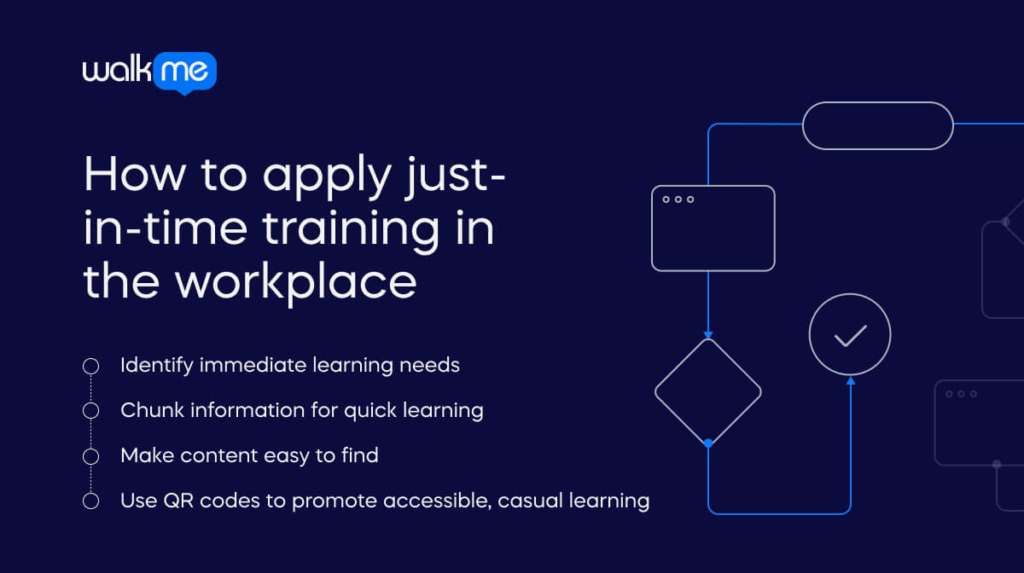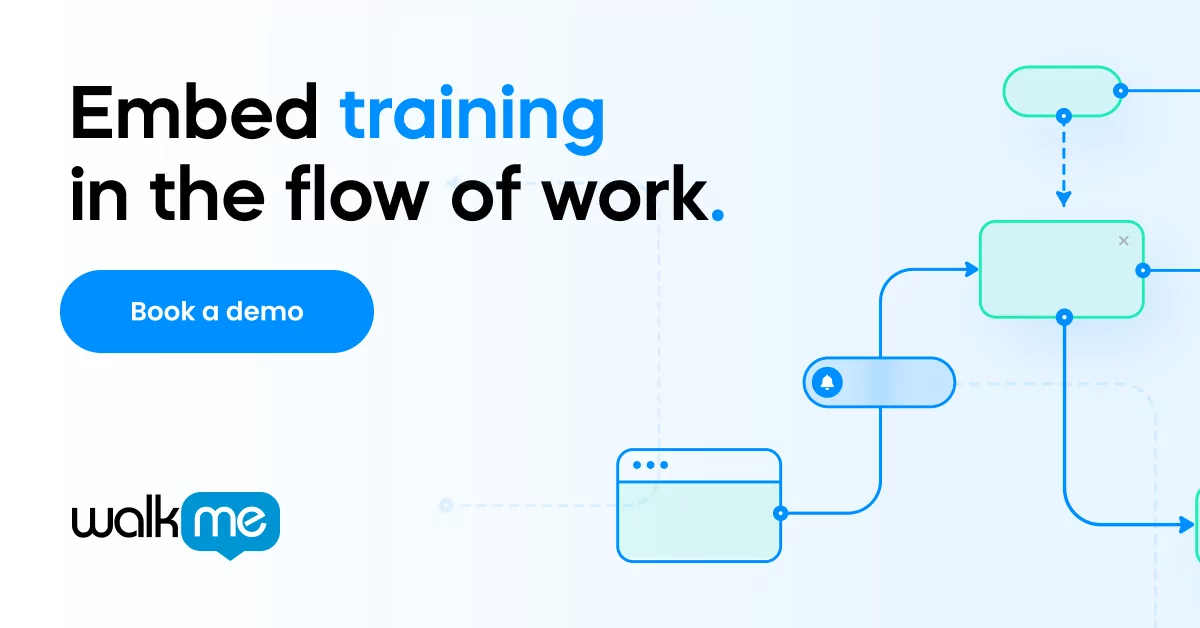Just-in-time training is employee training that pupils absorb and use quickly.
Students who manage their learning goals are four times more likely to engage with their learning.
The just-in-time approach can help learners take control and access training when needed. This method allows trainees to learn what they need and want, increasing productivity by 17%.
This article will show you what just-in-time training is, how to implement it, benefits and challenges, and examples.
By the end of this article, you’ll know how to use this training type to support your staff with the skills they need and improve performance and innovation.
What is just-in-time training?
Just-in-time training is a way of learning that gives employees information when needed. It is one of the fastest and most efficient methods of training.
It’s like having an online training resource staff can quickly access on their work phone, tablet, or computer. This convenience allows them to find information when they need to know something and need help right away, improving employee productivity.
The upshot is they won’t have to yawn through long lessons. Your people get the right amount of information to solve your problem immediately using efficient and accessible online training software.
Anyone responsible for crisis management and sales reps in the field falls in love with just-in-time training. It can also increase job satisfaction and employee retention as staff feel able to develop and grow.
Staff can find and use the information right away. When they enjoy learning skills quickly, their performance skyrockets, and revenue increases.
Who is the target audience for just-in-time training?

Most professionals would describe themselves as on-the-go within their role.
However, some roles fit this description better than others. Healthcare professionals, retail workers, manufacturing workers, and sales reps are roles that require a lot of work that happens away from the office.
Let’s look at these roles and how just-in-time training helps them.
Healthcare professionals
Healthcare professionals, such as doctors and nurses, benefit from just-in-time training. It helps them quickly learn about new medical procedures or equipment.
For example, if a hospital gets a new medical machine, staff can access a quick training video or guide on their phones or tablets.
This approach helps them learn how to use the machine right away, ensuring they provide the best care for patients. The main benefit is that it keeps patient care safe and effective without delaying treatments.
Retail workers
Just-in-time training feels tailor-made for retail workers in their quickly changing workplace. It helps them stay updated on new store products or sales techniques.
Imagine a store introducing a new product that a company will release the next day. Employees can watch a short training video on a tablet to explain its features to customers and encourage sales.
The benefit is that employees can answer customer questions and make sales more easily, improving the shopping experience.
Manufacturing workers
Manufacturing workers use just-in-time training to learn how to operate new machines or handle new tasks.
Consider a factory that gets a new type of assembly line. Workers can access training materials through a computer or tablet. Absorbing new information in this way helps them learn how to use the latest equipment quickly.
The benefit is that production runs smoothly without long delays, helping the factory stay efficient.
Sales representatives
Sales representatives also utilize just-in-time training. They learn about new products or sales strategies as soon as needed.
For instance, if a company launches a new product, sales reps can quickly get a training update via a mobile app or website.
This quick delivery of new information ensures they have the latest knowledge to share with customers right away. This approach can increase sales and provide accurate information, boosting their success.
Review the above professions and consider how they relate to your workplace. If the occupations and your employees overlap, it might be time to invest in just-in-time learning.
Examples of just-in-time training
The best way to understand a concept is to examine a few examples. This type of training can sometimes feel confusing, especially if you’re more familiar with traditional learning methods. Below are four approaches to help learners gain information as and when needed. These examples focus on engagement and speed of data access.
Flashcards
Flashcards in just-in-time training give small pieces of information quickly and simply. Employees use flashcards to review key concepts or procedures before or during tasks. They help them remember important details in an engaging way without needing lengthy training sessions.
Workers benefit by immediately getting the knowledge they need, boosting their confidence and performance.
For the organization, flashcards ensure that employees can easily access crucial information, leading to fewer mistakes and higher efficiency in their work.
Video tutorials
Video tutorials are great because they allow employees to learn information easily and access data quickly. They can discover step-by-step instructions on how to perform specific tasks.
In just-in-time training, employees can watch these videos when they encounter a problem or need to learn a new skill quickly. This visual aid makes it easier to understand and apply the information immediately.
Employees benefit from learning at their own pace and holding the information better. For the organization, video tutorials lead to quicker problem-solving and skill acquisition, enhancing overall productivity.
Micro assessments
Micro assessments are small quizzes or tests. They help employees be more independent by checking their understanding of the material they’ve just learned.
These tests align with just-in-time training because they are quick and focus on specific topics. This feature allows staff to access specialized training quickly to resolve issues.
They help employees identify areas for improvement and reinforce what they’ve just studied, which can increase their confidence in their abilities.
Organizational benefits include more effective training, more prepared employees for tasks, reduced errors, and increased job performance.
Product databases
Long lists of products might not align with the fast, convenient aims of just-in-time practices. However, they provide detailed information about products employees can access whenever needed.
Employees use these databases to find answers to product-related questions while they work. This ability ensures they have accurate information without delay.
Staff can quickly enjoy benefits as they gain the ability to assist customers or complete tasks more efficiently. The organization can use product databases to improve service quality and reduce the time spent searching for information, leading to better customer satisfaction and streamlined operations.
Consider these examples and how they might apply to your own just-in-time learning program.
How to apply just-in-time training in the workplace

There are four main ways to apply just-in-time training in your workplace environment. Identify needs, chunk information, increase search ease, and utilize QR codes. These methods will help you optimize your innovative new training program and engage your staff.
Before long, you will create a learning culture where every employee seeks learning and knows where to access new information when challenges arise.
Identify immediate learning needs
People in a fast-paced workplace need to learn new things quickly. The first step is to figure out what they need to learn immediately. This part of the process means finding out what skills or knowledge they need. They require these skills to do their jobs better or solve problems that are happening now.
When you know these needs, your company can focus on creating the right lessons for their workers. This way, everyone gets the training they need exactly when they need it.
Chunk information for quick learning
You know what needs to be taught. What next? You need to break down the information into small, easy pieces. This approach helps your people learn faster, as they can digest each piece of information easily.
Each small part is called a “chunk.” Workers can understand and remember the information more efficiently by focusing on one chunk at a time. Chunking makes learning quick and effective.
Make content easy to find
You’ve discovered needs and broken down the information. Next, you need to help workers find the information they need quickly. This part involved organizing the content so it is easy to search.
Use clear labels and categories so that when someone needs to find something specific, they can do it quickly. Well-organized content means workers don’t waste time looking for information. Instead, they can quickly get the necessary answers, helping them return to their tasks and utilize time efficiently.
Use QR codes to promote accessible, casual learning
QR codes are special phone-scannable squares that show information or videos. In the workplace, they can provide quick lessons when needed.
For example, if a worker faces a problem or has a question, they can scan a QR code to get the necessary information or instructions.
This makes learning convenient and immediate, helping workers solve problems on the spot.
How to measure the success of Just-in-Time training
You can measure a few things to see if just-in-time training works well.
First, we check whether people can remember what they learned. This metric is important because it shows whether how they use the training helps them retain the information.
Next, look at how quickly they can complete their tasks after training. This data tells us if the training improved their job performance.
You can also measure when employees can achieve a minimum confidence level in their tasks. Do so immediately after they have received just-in-time training. Shorter times indicate more effective training.
Finally, ask employees how they felt the training went. Use yes or no questions and refer to specific aspects of the training to allow you to improve the program.
These measurements help you know if the training was valuable and made a difference to employees and your organization.
Use Just-in-Time Training to increase performance
Just-in-time training might be a fairly new learning strategy, but it is essential to gaining a competitive advantage in today’s digital world.
Just-in-time training boosts performance by giving workers the exact help they need right when needed.
First, it makes learning fast and focused on what’s important. Second, it helps workers solve problems quickly. Third, it avoids wasting time on unnecessary information, so they stay productive and do their jobs better.
Invest in just-in-time learning today to increase performance within a culture of learning innovation and higher revenue with your skilled workforce.
FAQs
What are the four steps of the just-in-time process?
The four steps of the Just-in-TIme process include:
- Identify immediate learning needs: Determine what skills or knowledge employees need to perform tasks.
- Chunk information for quick learning: Break down information into smaller parts to make learning fast and easy.
- Make content easy to search: Organize content so employees can quickly find information.
- Use QR codes for teachable moments: Employees can scan QR codes to access instant training resources to resolve issues.
What is an example of just-in-time learning?
An example of just-in-time learning is when an employee needs help with a new software feature. They scan a QR code at their workstation. Scanning the code provides instant access to a tutorial video, allowing them to learn and use the feature immediately. This method avoids waiting for scheduled training or searching through manuals, delivering information when needed.
Is just-in-time training lean or agile?
Just-in-time training is lean and agile. It’s lean because it focuses on delivering only the essential training needed. This process minimizes waste of time and resources. It is agile because it adapts to changing needs and provides immediate learning solutions. This approach ensures that training is efficient and relevant. It’s also responsive to the real-time demands of the workplace.


